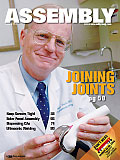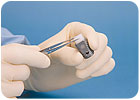
Human bones constantly undergo severe stress and strain. If you live long enough, chances are that you’ll eventually need to replace one or more joints due to injury, general wear and tear, or arthritis.
Demand for artificial hips, knees, shoulders, spines and other types of implantable joints is skyrocketing, making orthopedics one of the hottest segments in the medical device industry. To meet unprecedented demand, many orthopedic device manufacturers are attempting to adopt new types of materials, improve productivity and shorten time to market.
According to the National Center for Health Statistics (Atlanta), knee and hip replacement surgery has become much more common over the last decade. In fact, hospitalization rates for knee replacement procedures rose nearly 90 percent between 1992 and 2004 among people 65 and older. Today, the average age for total joint replacement patients is about 60, while 20 years ago it was about 70.
The market for reconstructive joint replacements is expected to increase steadily over the next decade. A recent study conducted by the Freedonia Group Inc. (Cleveland) claims the industry will grow 8 percent annually, from $6 billion in 2007 to $13 billion by 2017.
“The market will gain upward momentum from an aging population and the widespread prevalence of physically active lifestyles,” says Bill Martineau, healthcare industry analyst at the Freedonia Group. “These trends will expand the number of persons suffering from degenerative and injured joints.”
Knees and hips, which are highly vulnerable to degeneration caused by arthritic conditions, will continue to account for the vast majority of reconstructive joint replacements. “Continuing advances in materials and design will improve the safety and performance features of knee and hip implants and encourage their expanding use in the treatment of severe arthritis,” Martineau points out.
“Among other reconstructive joint replacements, shoulder systems will post the strongest demand and realize the best growth opportunities based on advantages over alternative therapies in the reduction of pain and restoration of mobility,” adds Martineau. “Advances in product technologies and related surgical techniques, coupled with an increasing prevalence of chronic back conditions, will also create strong growth opportunities for spinal implants.”
The orthopedic device market is dominated by a handful of manufacturers, including Biomet Inc. (Warsaw, IN), DePuy Inc. (Warsaw, IN), Medtronic Inc. (Minneapolis), Smith & Nephew (London), Stryker Corp. (Kalamazoo, MI), Synthes Inc. (Solothurn, Switzerland) and Zimmer Holdings Inc. (Warsaw, IN). Martineau says those seven companies control more than 80 percent of the U.S. market.
At next month’s annual American Academy of Orthopedic Surgeons (Rosemont, IL) meeting in Las Vegas, implant manufacturers are expected to unveil new products that address the following trends:
- Minimally invasive surgery. During the past few years, the industry has been moving toward more minimally invasive procedures that call for innovative surgical instruments and orthopedic devices.
- Better biomaterials. Advancement in the biomaterials used in implants continually drives the orthopedic device market. Orthopedic surgeons and their patients are looking for better wear-resistance, longer life, increased bone integration and improved weight-bearing capabilities.
- Custom designs. Today, “gender knees” are a hot topic in the orthopedic profession. Several companies are offering products that accommodate the differences in male-female body structure.
- Bearing surfaces. With the average age of joint replacement patients becoming younger and younger, the traditional metal-on-metal implant is generating too much wear. Orthopedic surgeons are moving toward using metal-on-plastic designs until a better alternative emerges.
“It will be important for companies to develop cost-effective methods to manufacture devices and make them available to the market at the best price,” says Aarti Shetty, healthcare industry analyst at Frost & Sullivan Inc. (San Antonio). “Technology innovation has to be a continuous pattern in developing methods of production that can cater to the needs of surgeons and patients, and also increase the life of the implants.
“Though the materials world has seen a lot of development, just as in every other sector of medical device development, there’s lot of room for improvement, particularly in areas involving device wear and the avoidance of debris that can turn a good implant into a lot of pain and anxiety for the patient. Thus, manufacturers have to be on their toes to provide a more solid solution.”

Material Challenges
Joint replacement implants typically have short product life cycles. Excessive material wear often causes orthopedic devices to deteriorate in approximately 10 to 15 years. “The million-dollar question that most surgeons want to know is if manufacturers can help them find an implant that can last a lifetime and still continue to provide normal joint function,” says Shetty.
As a result, material selection plays a critical role in manufacturing artificial hips, knees, shoulders and other implantable devices. Metals are often prescribed, with titanium alloy widely used due to its biocompatibility with the human body. Titanium also features mechanical properties that are closer to bone when compared to other FDA-approved metals, such as stainless steel and cobalt chrome alloys.
Titanium and titanium alloys can be welded using arc, spot, seam, flash, pressure, friction, electron beam and laser methods. “Laser welding is the process of choice to hermetically seal orthopedic implants,” explains George Ritter, technology leader in engineering, materials and structural integrity at the Edison Welding Institute (EWI, Columbus, OH).
“Laser joining is a contact-free process, therefore minimizing mechanical load on the parts to be joined,” Ritter points out. “The controlled heat input decreases the potential for thermal damage to the highly sensitive components. Laser joining also offers flexibility, shorter processing time and higher quality.”
But, titanium poses unique challenges to medical device engineers. “In general, joining procedures and equipment are similar to those used to join stainless steels and aluminum parts,” says Jose Ramirez, principal engineer at EWI. “However, because titanium and titanium alloy are extremely reactive above 1,000 F, additional precautions must be taken to shield the joint from air.”
The titanium industry has experienced supply chain problems, due to extremely high demand and limited supply of raw materials. According to Shetty, demand for titanium mill products has increased 50 percent over the last six years. “The increase in demand is predominately due to the aerospace industry, coupled with growth in other key markets such as medical, industrial and recreation,” he points out.
“In addition, only a limited number of suppliers service the orthopedic industry with these materials,” adds Shetty. “Thus, a purchaser’s ability to shop around for price is constrained. The profit margins to be gained by [supplying] the medical industry are not sufficient to attract many suppliers. [That’s why] orthopedic device manufacturers have been searching for substitute materials.”
Alternatives to titanium include cobalt chrome and nitinol. Cobalt chrome alloys are widely used for orthopedic implants in Europe because they offer high strength, low weight, and excellent wear and corrosion resistance. Nitinol is a biocompatible alloy that contains nearly equal amounts of nickel and titanium.
“Cobalt chrome has an advantage of being easier to work with than other traditional materials,” says Shetty. “Nitinol has been generating added interest in the market with its shape-memory properties. It also has high elastic strength.”
The newest material that holds promise for orthopedic device applications is zirconium, which reduces generation of wear debris. Ceramic is also capturing a growing share of the market.
In addition, polymers such as ultra-high molecular weight polyethylene are used by orthopedic device manufacturers. “They act as lubricant-like materials to allow easy movements of the metallic protheses, thereby mimicking joint movements,” says Dr. Anson Ong, a biomedical engineering professor at the University of Texas at San Antonio.
No matter what type of material is used to make knees or hips, two of the biggest problems facing the orthopedic device industry are the wear debris generated by metallic and polymeric materials during movement and the initial bone-implant integration with tight-fit prostheses.
“Day-to-day use of artificial joints causes them to shed tiny debris and microscopic particles,” says Len Czuba, president of Czuba Enterprises Inc. (Lombard, IL), a medical device design firm. “That can cause inflammation and degradation of tissue, leading to patient discomfort.”
According to Czuba, the biggest challenge facing orthopedic device engineers is coming up with appropriate wear surfaces. Surface treatment or coating is an important part of the manufacturing process. The surface is in contact with the body and determines how well natural bone integrates with the implant over time.
“Engineers are searching for materials that are less stiff, so that joints can bend and flex naturally, and materials that are more porous, so that joints can adhere better to bone,” explains Czuba. “They’re becoming more creative in their selection and use of materials.” In the future, Czuba predicts the industry will use more bioresorpable materials, rather than traditional titanium, because they give design engineers more latitude and flexibility.
Engineers at the National Research Council of Canada (Ottawa, ON) have combined plastic materials and titanium foam to create a new material that features an open cell structure that’s similar to that of human bones. The structure, corrosion resistance, biocompatibility and mechanical properties of the porous titanium foam make it ideal for attaching implants to bone and tissue.
“The current trends in orthopedic device manufacturing are the optimization of implant surfaces for improvement of wear and osteointegration,” adds Dr. Ong. Specifically, he says manufacturers are eager to find:
- A material that will mimic articulating joints, but at the same time minimize the generation of wear debris.
- A biocompatible material that has a closer match in mechanical properties to bone, since a mismatch can cause bone to become osteoporotic.
- A biocompatible material that will allow easy fabrication of devices, but at the same time also induce rapid bone-implant integration.
“Fabrication of devices can be challenging,” notes Ong. “New technologies have to be developed whenever a new material is used. Additionally, manufacturers often have to seek FDA approval, which can be very time consuming.”

Lean Times
Most orthopedic devices are mass-produced, but manufacturers are moving away from traditional batch processing. They’re using more one-piece flow processes that improve productivity and increase quality, while reducing cost and margin of error.
Rick Harris, president of Harris Lean Systems Inc. (Murrels Inlet, SC), claims there is a tremendous opportunity to apply lean manufacturing principles in the orthopedic device industry. “Most knee joints are basically made the same way, except measurements are different,” he explains. Each product has to be matched to the patient. For instance, age and weight are extremely important factors.
“If a production day or shift calls for 100 knees, chances are they’ll all be slightly different,” says Harris. “Some implants will take two minutes to make, while others may take eight minutes. There’s a huge opportunity for the industry to apply lean to the way that they schedule production.”
According to Harris, most artificial joints are manually assembled from standard components. “Manufacturers typically use screws to put the parts together,” he explains. “They often make different product families classified by takt time. For instance, approximately 60 percent will be made-to-stock items, 20 percent will be semirepeatable, 10 percent will be nonrepeatable and 10 percent will be unique.”
While assembly is important, machining is the most challenging part of mass-producing orthopedic devices. “Buffing and polishing have a crucial role in the orthopedic implant manufacturing process,” says Shetty. “High standards are set to achieve maximum precision so that high quality is maintained throughout the life of the implant and failure is avoided. If the surface of the implant is not smooth enough, there is a very high chance that the implant might not have enough wear resistance and may eventually fail when the two joint surfaces repeatedly rub against each other.
“We are increasingly seeing automated manufacturing processes in the orthopedic industry,” adds Shetty. “[Manufacturers are] using robotic technology for polishing, buffing and [milling] metal parts used in implants. Automation is expected to take a front seat in implant manufacturing in the near future.”
Mark Handelsman, industrial marketing manager at FANUC Robotics America Inc. (Rochester Hills, MI), says many orthopedic device manufacturers use six-axis robots for polishing and buffing applications. “They tend to be very demanding about the material removal process,” he points out. “They can’t afford to find out about a problem after the implant is in place.
“Also, the materials they use are very expensive, so there’s a big need to eliminate waste and improve quality,” adds Handelsman. While manufacturers are not using robots for assembly applications yet, they are starting to use 3D vision technology for material handling.
To learn more about orthopedic device manufacturing trends, search for these articles on ASSEMBLY’s Web site:
- Bone-Growing Nanomaterial Could Improve Artificial Joints.
- Demand for Implants Will Skyrocket.
- Knees Need Special Assembly.
- Some Knees Are Gender Benders.
- Titanium Coating Improves Orthopedic Implants.

